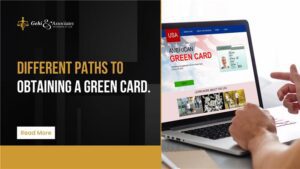The Green Card is a gateway to stability, opportunity, and long-term residence in the U.S. Whether you’re a student, professional, or pursuing relief through asylum or the DV Lottery, each path carries advantages and risks. Understanding these differences is the key to building a strategy that aligns with your future.
For international students in the U.S., the path to permanent residency is especially murky. Should you find an employer sponsor and move from OPT to H-1B to EB-2? Should you marry a U.S. citizen? Or do political changes back home justify an asylum application? Each choice impacts your legal status, quality of life, work freedom, and family planning.
Similarly, spouses and children of U.S. citizens might assume they’re on the fastest route. That is, until they experience bureaucratic delays or high RFE rates. Queens Immigration Attorney provides personalized legal services. Guiding those stuck between options, feeling overwhelmed by paperwork, or second-guessing their chosen route. Offering clarity to dreamers, students, skilled workers, and family members trying to find their footing in the U.S. immigration system.
Key Statistics:
- U visa applicants can apply for a Green Card after 3 years in U status.
- Asylum-based applicants can file for a Green Card 1 year after grant.
- The Diversity Visa (DV) Lottery has a 45% post-selection denial rate.
- USCIS conducts biometrics appointments around 5–8 weeks after Form I-485 is filed.
- Marriage-based AOS (adjustment of status) takes about 9.2 months on average.
- Employment-based Green Cards like EB-2 or EB-3 can take 1–3 years.
Green Card Options for International Students 2025
International students often arrive in the United States with one goal: to complete their studies and graduate. However, when the program ends, many ask, “What now?” Transitioning from a student visa to permanent residency is not automatic. It requires handling complex rules and timelines under time pressure and legal uncertainty.
Many students fail to consider immigration planning. This delay can lead to panic, status violations, or rushed decisions. An experienced immigration attorney helps prevent costly missteps.
OPT to H-1B to EB-2
This is the most structured but competitive path. It starts with Optional Practical Training (OPT), a work period granted to F-1 students after graduation. For STEM majors, OPT can extend up to 36 months. During this time, the student must secure an employer willing to file an H-1B petition.
The H-1B visa is subject to a lottery. Not all applicants are selected, which creates uncertainty. If selected, students work under H-1B status and can later be sponsored in the EB-2 category. However, EB-2 requires an advanced degree or a bachelor’s degree plus 5 years of progressive experience. It also typically requires a PERM labor certification, which can take 6 to 18 months. Filing the I-140 immigrant petition and the I-485 adjustment of status application can take years. Processing times vary based on country of origin and visa bulletin availability.
F1 to Green Card via Marriage
Marrying a U.S. citizen while in valid F-1 status is one of the fastest routes. Immediate relatives of U.S. citizens do not face visa caps or waitlists. The agency looks for signs of marriage fraud. You must provide joint lease agreements, shared financial accounts, photos, and proof of a bona fide relationship. Even if the relationship is genuine, missing documents can trigger an RFE.
F1 Asylum Adjustment
F-1 students from politically unstable or unsafe countries may file for asylum. If granted, asylum allows you to stay legally and apply 1 year after approval. The path bypasses the visa bulletin, making it potentially faster than family-based routes from backlogged countries. However, the success of an asylum claim depends entirely on your personal story and country conditions.
Timing Considerations
Each pathway differs significantly in timing and complexity. OPT to H-1B to EB-2 is the slowest, often spanning 6 to 10 years. This includes time for PERM labor certification, I-140 approval, and visa bulletin movement. It’s also the most precarious, as every step depends on external approvals.
Marriage-based cases can wrap up in less than a year, if well-prepared. However, they come with intense scrutiny and emotional stakes. Asylum timelines vary widely. Some applicants wait 3 to 5 years just for an interview.
Which Path Works Best?
The “best” path depends on your life circumstances. Marriage offers speed and flexibility if you’re in a genuine relationship and your partner is a U.S. citizen. For STEM graduates with offers from Fortune 500 companies, OPT to H-1B to EB-2 offers long-term viability.
If you face real danger at home, asylum is your safest legal defense. But it carries the highest documentation burden and lowest predictability. Only those with a well-documented claim and country-specific evidence should pursue it. Choosing the right path is less about popularity and more about fit. A local immigration attorney in Queens can assess your eligibility, prepare airtight filings, and protect your future in the U.S. This is echoed in client reviews, highlighting their successes in complex cases.
Self-Petitioning: EB-1A, NIW, and Beyond
Many believe a U.S. employer or a family sponsor is always required. That’s no longer always true. If you have exceptional skill, advanced education, or a significant public impact, you may be able to sponsor yourself.
EB-1A
The EB-1A category is designed for people at the very top of their field. This includes recognized experts in science, business, athletics, the arts, and education. To qualify, you must prove extraordinary ability. Meaning your skills are significantly above others in your field and widely recognized.
You must submit evidence showing either a major international award or meet at least 3 out of 10 strict criteria. These include:
- National or international prizes.
- Published material about your work in major media.
- Original contributions of major significance.
- High salary compared to peers.
- Authorship of scholarly articles.
- Leading roles in distinguished organizations.
Beyond this, you must prove that you will continue working in your field and that your work will benefit the U.S. You can self-petition and don’t need a job offer, but you must prepare your petition with precision. USCIS will review everything as a whole to decide if you’ve risen to the very top of your field.
EB-2 NIW
The National Interest Waiver (NIW) allows certain EB-2 applicants to skip the job offer and PERM labor certification. It’s ideal for those whose work offers clear, measurable benefits to the U.S. Entrepreneurs, researchers, doctors, and independent consultants often use this route.
To qualify for an NIW, you must:
- Have an advanced degree or demonstrate exceptional ability.
- Prove your work has substantial merit and national importance.
- Show you are well positioned to advance the work.
- Demonstrate that waiving the labor certification benefits the U.S. “on the balance” more than requiring it.
The NIW does not require a sponsoring employer. It favors applicants who show that their work will continue to serve U.S. interests long term. Compared to EB-1A, this category is more about impact than prestige. This makes it a strategic fit for professionals whose achievements are less flashy but widely beneficial.
Approval Rates and Cost Comparison
The EB-1A is prestigious, but tough to get. Approval rates typically range between 50–60%, mostly because many applicants fail to show sustained acclaim. Incomplete evidence or weak documentation will quickly lead to denial. The NIW, however, sees stronger approval rates, about 75% when well-prepared. Its burden of proof is more flexible.
For both petitions, you’ll need to file Form I-140 and pay filing fees. If inside the U.S., you will need to submit Form I-485 for adjustment of status. Legal fees and documentation costs can add up. That’s why working with a Queens Immigration Attorney early in the process helps avoid costly RFEs or denials.
No Employer Sponsorship Required
Both EB-1A and NIW offer the rare benefit of independence from employers. This is a major advantage for:
- Entrepreneurs launching startups.
- Freelancers or consultants.
- Academics transitioning from student to permanent resident.
- Public-sector professionals working on nationally beneficial projects.
Applicants don’t need to risk job loss, layoffs, or relocation mandates. You control your petition, your pace, and your supporting evidence. This autonomy makes self-petitioning ideal for those with non-traditional or interdisciplinary career paths. Self-petitioning still demands precision. You must meet all legal standards without help from your employer’s HR department.
Before making your next move, check out legal tips from a seasoned Queens, NY immigration attorney.
FAQs
What is the fastest way to get a US green card? Marrying a U.S. citizen is typically the fastest route. This path allows for the concurrent filing of Form I-130 and Form I-485, significantly reducing wait times. In most cases, applicants can receive their Cards within 9 to 12 months if the paperwork is correctly filed.
What is a green card vs. citizenship? A Green Card grants you lawful permanent residency, allowing you to live and work in the United States indefinitely. Citizenship, on the other hand, gives you full legal rights. Including the ability to vote in federal elections and obtain a U.S. passport. Holders remain citizens of another country and still face removal under certain conditions.
What is the current wait time for a green card? The wait time depends heavily on the category under which you apply. Immediate relatives of U.S. citizens typically receive Green Cards in less than a year. Categories like F3 (married adult children) or EB3 (skilled workers) can involve delays of 10 years or more. Country of origin and visa bulletin availability also significantly impact timelines.
Can I stay on my green card forever? Yes, you can remain a permanent resident indefinitely as long as you meet residency requirements. You must renew your Card every 10 years using Form I-90 to maintain valid documentation. However, long absences from the U.S. or intent to live elsewhere can lead to abandonment of status.
What are the disadvantages of a green card? Holders cannot vote in federal elections and may be deported for certain criminal convictions. They are also subject to U.S. tax laws on worldwide income, just like citizens. Additionally, they must maintain residency to avoid losing their status.
Do green card holders get Social Security? Yes, holders are eligible to receive Social Security benefits. That is, after working and contributing to the system for at least 10 years (40 quarters). Eligibility and benefit amounts are calculated in the same way as for U.S. citizens. However, early withdrawal or limited work history can reduce available benefits.
Your Journey Deserves the Right Advocate
In Queens, NY, the need for experienced, compassionate, and culturally aware immigration attorneys is greater than ever. A skilled attorney can help you anticipate delays, reduce RFEs, and increase your chances of approval. No matter your chosen path. That’s why partnering with an experienced Queens Immigration Attorney gives you the edge you need. Book a free consultation today for clear legal direction grounded in up-to-date policies and community-based insight.





